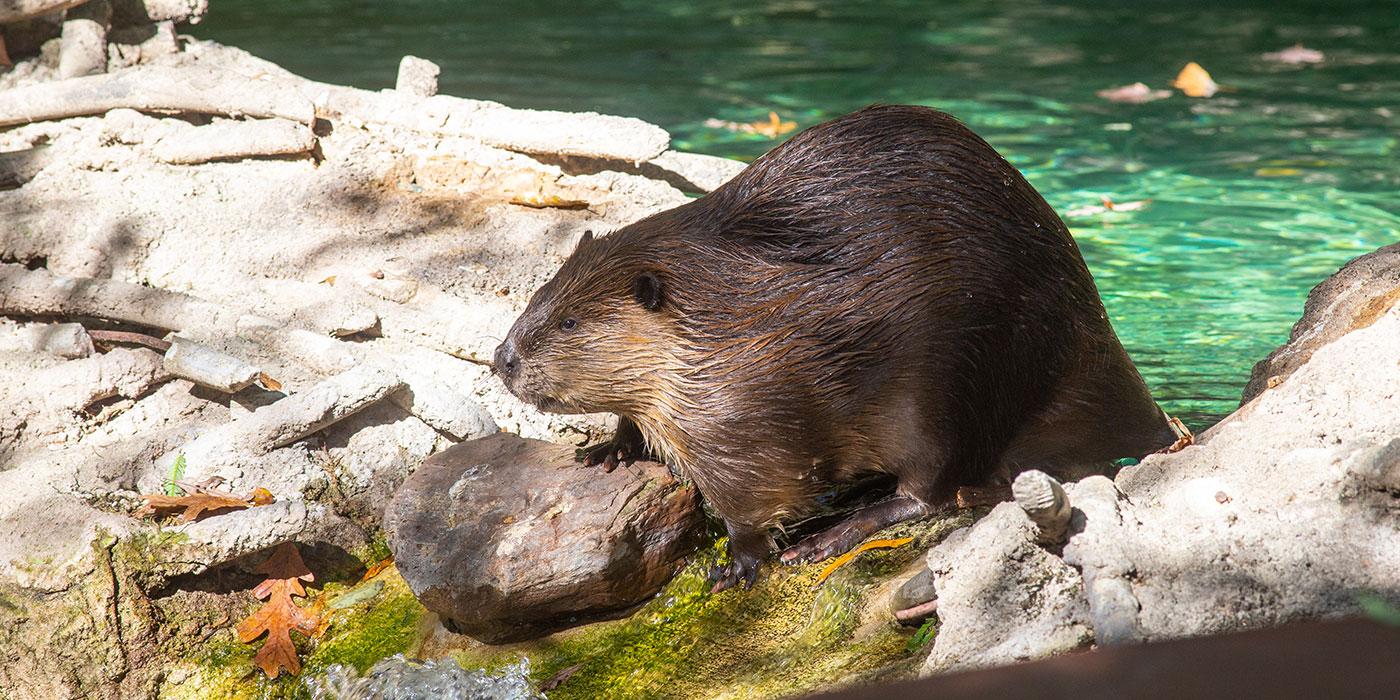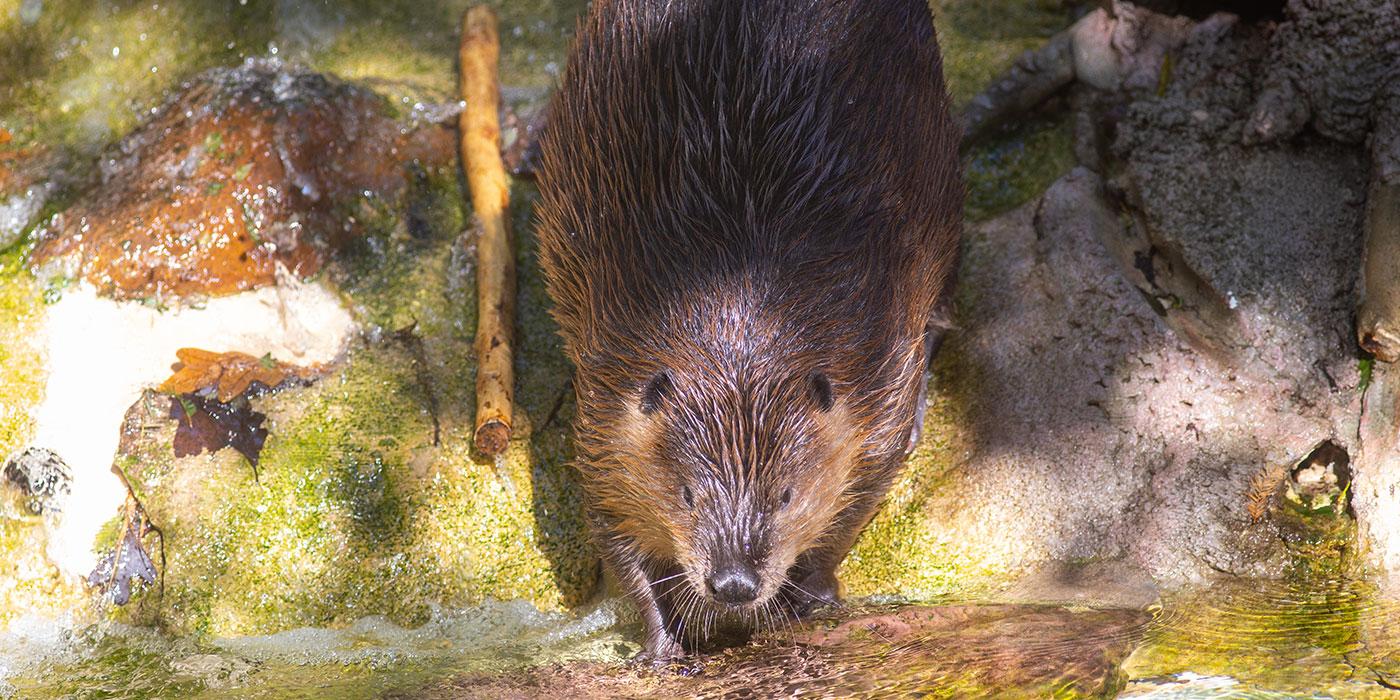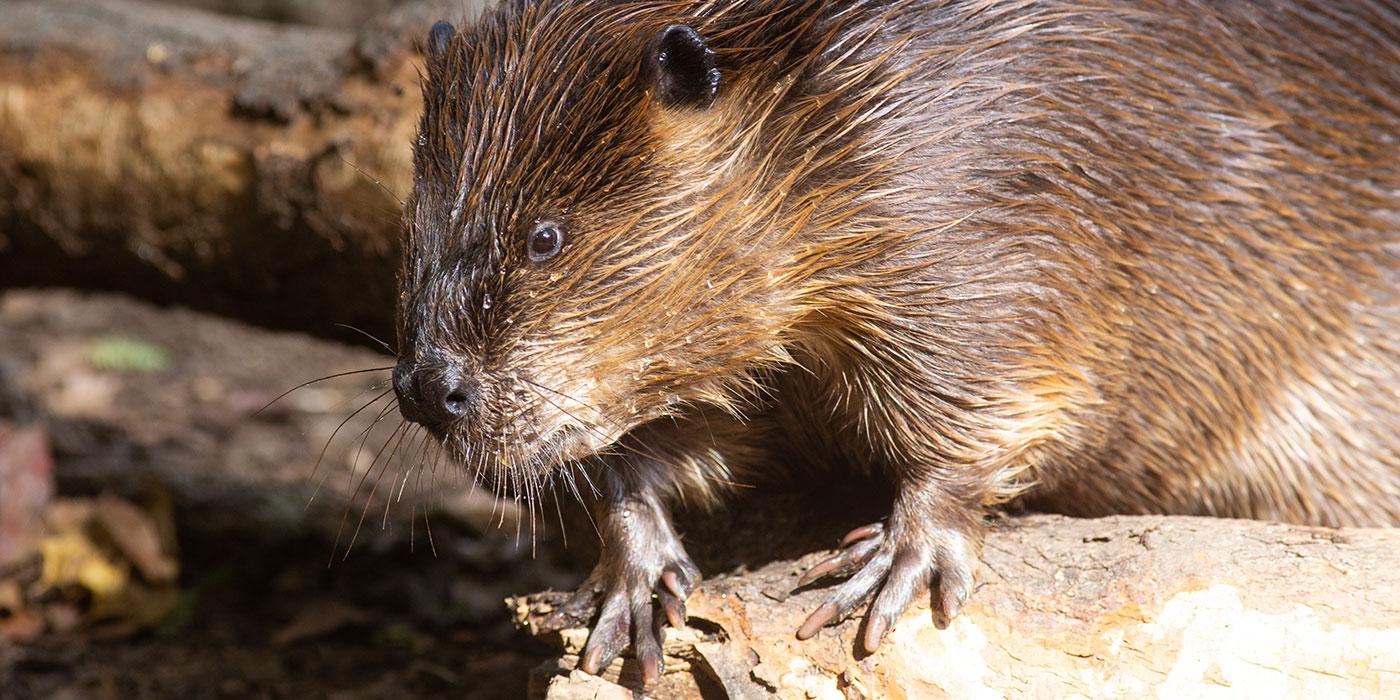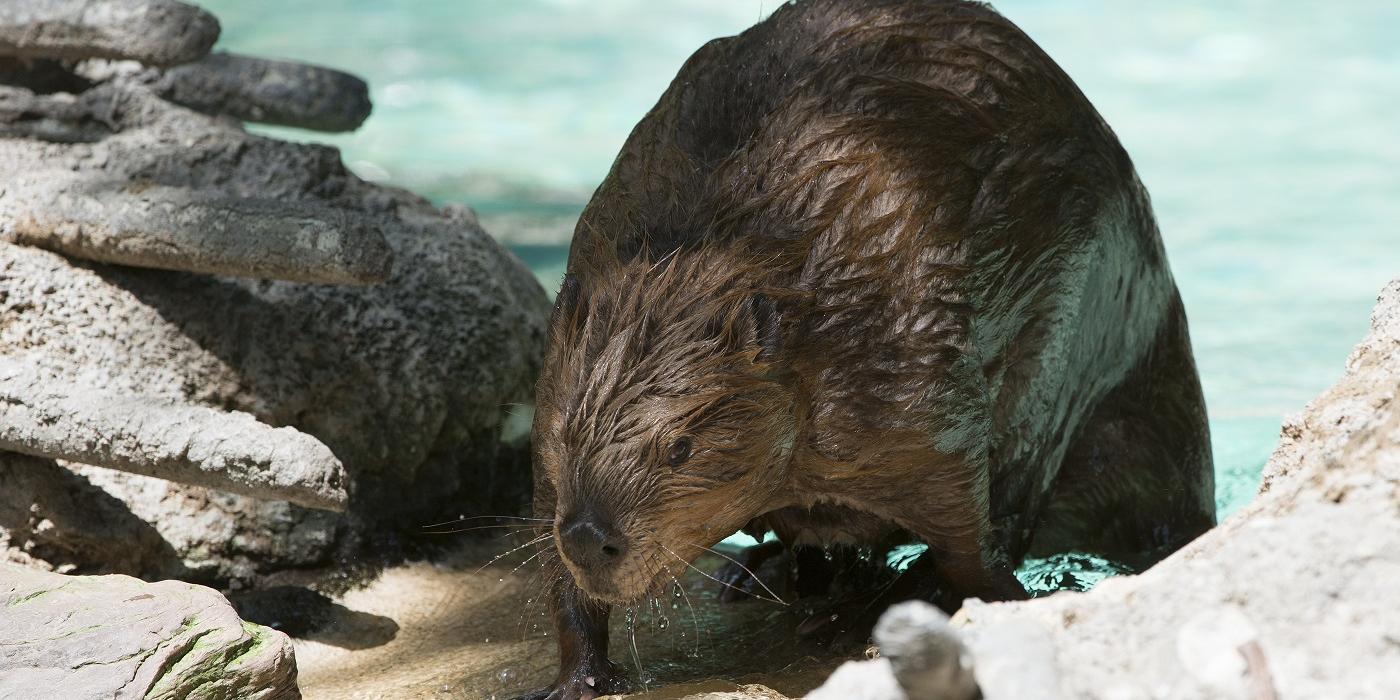Physical Description
North American beavers have stocky bodies with a yellow-brown to almost black coat and a broad, flat, scaly tail. Their large, orange incisors grow continuously throughout their lifetime. They have webbed rear feet and digitated front paws. The beaver's stocky body enables it to conserve heat.
A beaver's long, dark-orange, visible incisors grow continuously throughout its life and are worn down through daily use. These teeth are self-sharpening and can cleave a willow the size of a person's finger in a single bite! If the incisors become too long, they can prevent the beaver's mouth from closing enough for its grinding molars to meet, which could lead to starvation.
Beavers regularly move between aquatic and terrestrial environments. Their small, dexterous front feet are well adapted to working on land. They walk on five digits, grasp sticks with their front paws and have well-developed digging claws. Their larger hind feet are webbed for swimming and void of fur, except on the dorsal surface.
The hind feet also have a preening toe, the second from the inside, with a unique double toenail. Beavers are meticulous groomers. They use the preening toe as a comb to prevent their fine, soft fur from matting to maintain its waterproofing and insulating properties. These flexible toes also remove burrs and parasites.
On land, a beaver's movements are extremely awkward, making them vulnerable to predators. In water, however, beavers can swim up to 6 mph (10 kilometers per hour). Their oversized lungs allow them to stay submerged for up to 15 minutes while traveling over half a mile.
Whiskers help detect objects around a beaver's face and head, which is especially helpful in narrow passageways and dark water. The beaver's eyes have a thin, transparent membrane, called a nictitating membrane, which is pulled over the eyeball for underwater work. A beaver's sight is good only for short distances and at close range. Its ears are external, small and rounded, with valves that also close while submerged, and the beaver's auditory sense is well developed.
The shape of the tail is an individual and family trait, varying from short and broad to long and narrow. It is practically hairless and covered with black scales. There is a sharp demarcation between the fur and the scales, the fur remaining at full length and density right up to this line. The tail is used as a rudder in swimming, as a balance prop while working on land and to signal danger when slapped on the water. Beavers will also store fat in their tails, eating more in the fall so they can survive off the fat stored in their tails through winter if food is not available. The beaver's vertebrae continue into and almost to the end of the tail.
Size
North American beavers are the largest rodents in North America and the second largest in the world (South America's capybaras being the heaviest). They weigh between 35 and 65 pounds (16 to 30 kilograms), with the heaviest beaver on record weighing 110 pounds (50 kilograms).
They are 3 to 4 feet (1 to 1.2 meters) long and stand 1 to 1.5 feet (0.3 to 0.5 meters) tall. The shape of the beaver's tail varies but, in general, is about 2 inches (5 centimeters) thick at the base and tapers to about 0.24 inches (0.6 centimeters) at the tip.
Native Habitat
Beavers are found throughout North America with the exception of the California and Nevada deserts and parts of Utah and Arizona. They live in ponds, lakes, rivers, marshes, streams and adjacent wetland areas.
Beavers are one of the few animals that modify their habitat; they build watertight dams of sticks woven with reeds, branches and saplings, which are caulked with mud. Dams reduce stream erosion by forming slow-moving ponds. These ponds serve as habitat for a wide range of small aquatic life and also provide water and food for much larger animals. By building dams, beavers create new habitats that can support an incredibly diverse biological community.
Beavers also build dome-like lodges that rise 6.5 feet (2 meters) or more and can reach widths of 39 feet (12 meters). A lodge can have one or more underwater entrances and living quarters are located in the top of the lodge above the water line. Often built away from the shore, these lodges form islands that can only be entered from underwater. The lodge chamber may be 4 feet (1.2 meters) wide and 2 feet (0.6 meters) high, insulated by walls one-third of a meter thick and ventilated by a small air hole in the roof called a "chimney." Typically, the floor is covered in wood shavings to absorb excess moisture and provide bedding. Beavers spend the summer and fall building dams and gathering and storing food for the winter.
Lifespan
North American beavers typically live 10 to 12 years. The oldest on record lived 30 years in human care.
Communication
One important communication signal among beavers is a tail slap on the surface of the water, indicating danger. Typically performed by an adult, this alarm signal alerts others in the area to seek refuge in deep water. It may also frighten a predator.
Beavers communicate outside of their family unit by depositing scents around the edges of their territory. The beaver is unique among rodents in that it builds scent mounds — heaps of mud, sticks and grass up to one-third of a meter high and about a meter wide on which they deposit scents from their anal glands.
Beavers have important castor and oil glands near the anus. Castor, a very pungent, thick liquid, is produced for scent marking and leaves a long-lasting odor. The oil glands produce the oil used to waterproof a beaver's fur. The oil is slightly different between the sexes and is used in reproductive communication.
Within the lodge, beavers employ various vocalizations (though their voice box is rudimentary) and postures to communicate with family members. At the Smithsonian's National Zoo, beavers have occasionally been heard hissing if they are unhappy.
Food/Eating Habits
Beavers are herbivores, eating leaves, woody stems and aquatic plants. Their chief building materials are also their preferred foods: poplar, aspen, willow, birch and maple.
In cold climates, they spend the winter inside their lodge chamber, feeding on branches they have stored on the muddy pond floor as a winter food supply. The water acts as a refrigerator, keeping the stems cold and preserving the nutritional value. Beavers hold their food with their front paws, eating corn-on-the-cob style.
At the Smithsonian's National Zoo, they eat mixed vegetables, rodent chow, leafy greens and a healthy supply of wood.
Sleep Habits
Beavers are mainly nocturnal throughout their range. However, in regions where ponds freeze over throughout the winter season, beavers may stay in their lodges or under the ice using their fat reserves and feeding off the cache they have gathered.
In the lodge and underwater, light levels remain constant and low during the 24-hour day, so sunrise and sunset are not apparent. In the absence of solar "cues," a beaver's activity is not synchronized with the solar day. The circadian rhythm, or regular day cycle, breaks down, and beaver "days" become longer, varying in length from 26 to 29 hours. At the Zoo, beavers usually wake up in the early evening, around 4 p.m.
Social Structure
Beavers form strong family bonds. They are social animals, and each group is made up of one breeding pair, the year's kits and the surviving offspring from the previous year, called yearlings. There may also may be one or more sub-adults, 2 years or older, of either sex from previous breeding seasons. These subadults generally do not breed.
In winter, these family groups live together in their lodge and share food from the common larder (stored food supply). Their family life is exceptionally stable and is based on a hierarchy in which adults dominate yearlings and yearlings dominate kits. Physical aggression is rare and vocalizations, gestures and postures are used within the lodge to communicate issues of dominance status within the group.
Reproduction and Development
It's generally believed that beavers pair for life. They breed in the winter from January to late February, and females give birth in the spring.
Kits are born weighing about 1 pound (0.5 kilograms) with their eyes open and completely covered with fur. They take to the water inside the lodge within a half hour after birth. They are skillful swimmers within a week but are too buoyant to dive.
Kits typically stay close to their mother in the lodge for the first few weeks, nursing frequently and gaining considerable weight. Females have four nipples and sometimes sit upright to nurse. There is evidence of teat sharing among kits, which may explain the high survival rate of all members of a large litter. Kits nurse for about six weeks, and all members of the family share in bringing solid food to them.
On land, mothers often carry kits on their broad tails, sometimes even walking erect and holding them in their paws. In the water, kits may rest upon their mother's back. The young remain with their parents for two years, helping with lodge maintenance and raising the next generation of kits until they are, usually, driven away just before the birth of a new litter.
Conservation Efforts
Beavers are a classic story of American conservation at its worst and at its best. During the early 19th Century, beaver pelts were the single most valuable commodity in most of North America. Much of the exploration of the New World developed from the fur trade. Wars, including the French and Indian War, were even fought over access to beaver trapping areas.
Beaver fur was in constant demand for robes, coats, clothing trim and top hats (called beavers). Beaver fur was fashionable in European capitals, and some of America's great financial empires and real estate holdings were founded on the profits of beaver fur. With trapping totally unregulated well into the 20th Century, beavers all but disappeared from most of their original range.
Now protected from over exploitation, beavers have reestablished themselves over most of the continent and have even become an agricultural pest in some regions. Beaver dams can change a farmer's stream into mud or swamp. Dams may also flood stands of commercial timber, highways and croplands, and may block the upstream run of spawning salmon.
However, beaver dams are also important. They maintain an ecological balance by controlling run off, erosion and floods, and they keep the water table high enough to support rich vegetation. Beavers have also supplied people with information on swimming techniques, dam building, engineering, natural fortification and flood control.
Beavers are still harvested for their fur and meat but are actively managed throughout most of their range. The beaver's main predator, besides humans, is the wolf. Other predators include coyotes, wolverines, bears, foxes and lynxes.
Help this Species
- Organize or attend a stream, river, lake or other waterway cleanup in your area to preserve aquatic habitats for local species.
- Share the story of this animal with others. Simply raising awareness about this species can contribute to its overall protection.
Meet the Animals
Two beavers, a male named Aspen and a female named Juniper, live on American Trail.
Animal News

Leaf-tailed Gecko Treated for Skin Cancer With Chemotherapy







